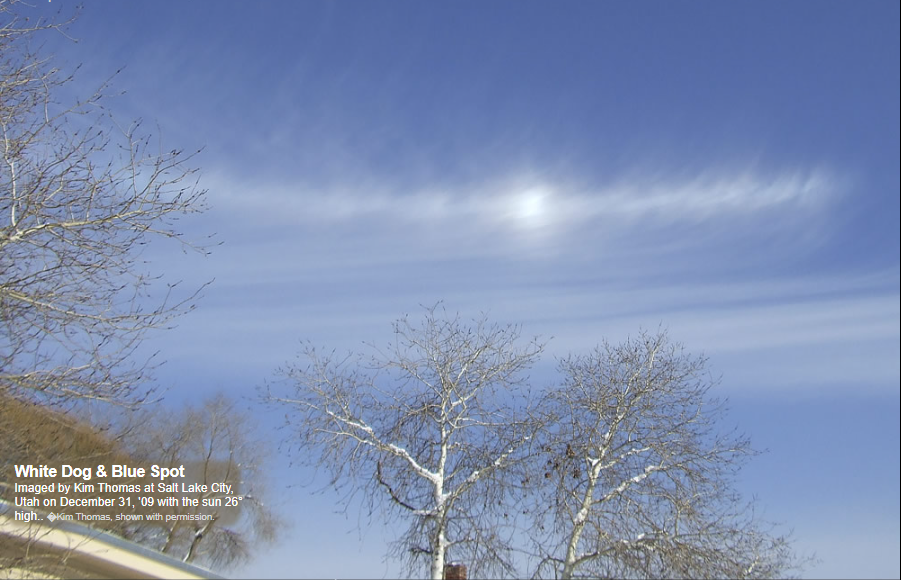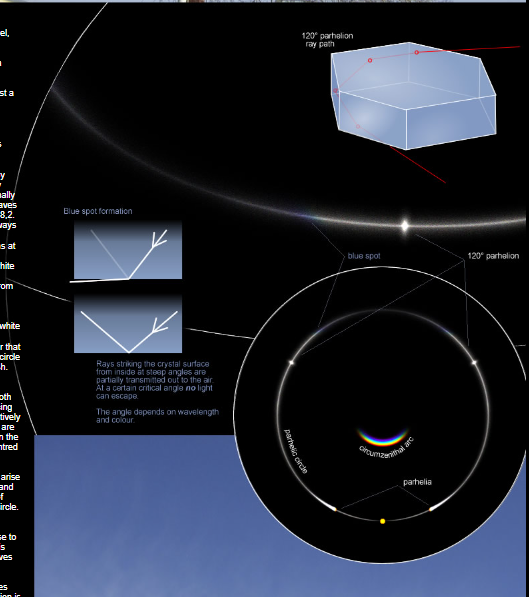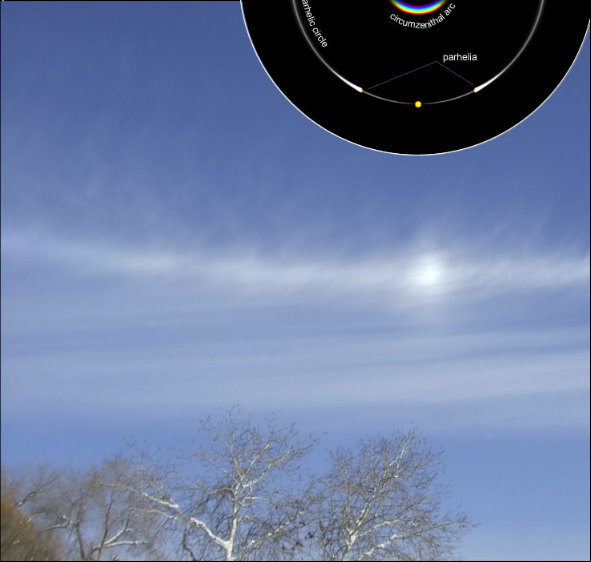White Dogs & Blue Spots
White Dogs & Blue Spots: A Fascinating Phenomenon in Atmospheric Optics
Have you ever looked up at the sky and noticed something unusual? Perhaps you saw a white patch or a faint bluish hue around the sun. These intriguing optical phenomena are known as "White Dogs" and "Blue Spots." While they may not be as well-known as rainbows or halos, they are equally captivating and worth exploring.
Discovering White Dogs
When halos appear in the sky, particularly sundogs, try looking at right angles to the sun at the same level. Then, cast your gaze a little further away from the sun. In some cases, you might come across a fascinating sight - a 120-degree parhelion, commonly referred to as a white patch.
These white patches are not easily visible against a whitish sky and often require careful observation to be noticed. However, some lucky individuals, like Kim Thomas in Salt Lake City, Utah, had the opportunity to witness a bright and expansive parhelic circle generated by ice crystals in cirrus haze and thicker cloud wisps.
The Formation of 120-degree Parhelion
The 120-degree parhelion is formed by plate crystals, which follow a specific path of light deflection. When a ray enters the top face of the crystal, it reflects internally from two side faces before exiting through the lower face. This path, known as path 1,3,8,2, always results in a light deflection of 120 degrees, regardless of the crystal's orientation.
Interestingly, the colour dispersions at ray entry and exit are in opposite directions and cancel each other out, resulting in a white halo. However, for this phenomenon to occur, the crystal needs to have several optically perfect faces, be free from internal defects, and possess thick plates, making it quite rare.
Unveiling the Blue Spot
While the parhelic circle is typically white, there are instances where it takes on a slightly bluish hue. If you observe the extreme left of the upper image or the lower right, you will notice that the parhelic circle becomes fainter and exhibits a hint of blue.
The colours and sudden fall-off in brightness are closely linked. These characteristics can be observed in the HaloSim tracing, which uses 60 million rays passing through relatively thick plate crystals. The tracing includes an all-sky view centered on the zenith and another approximately centered on the camera direction.
The Role of Reflection and Refraction
The transition between partial and total reflection within the crystal plays a significant role in the colour and brightness fall-off of the parhelic circle. When a ray internally reaches a crystal face at a steep angle (close to the normal of the surface), part of it is internally reflected while the rest leaves the crystal.
As the angle of incidence becomes less steep, a critical condition is reached, determined by the refractive index of the crystal. Beyond this critical condition, total reflection occurs, and no light leaves the crystal. This phenomenon accounts for the sudden fall-off in brightness observed in the parhelic circle.
Interestingly, the critical condition for total reflection is wavelength-dependent, meaning that blue rays reach it farther from the sun compared to other wavelengths. This is why we observe a faint bluish hue in certain parts of the parhelic circle.
A Mysterious and Enigmatic Sight
The presence of white dogs and blue spots in the sky adds an air of mystery and enchantment to our atmospheric optics experiences. While they may not be as commonly observed as rainbows or halos, their unique characteristics make them truly fascinating.
Next time you find yourself gazing at the sky, take a moment to explore its intricacies. Who knows what other hidden wonders await your curious eyes? Keep an open mind and let the atmospheric optics reveal its secrets to you.

White Dog & Blue Spot
Imaged by Kim Thomas at Salt Lake City, Utah on December 31, '09 with the sun 26° high.. �Kim Thomas, shown with permission.
When there are halos about, especially sundogs, look at right angles to the sun at the same level, Then cast your eye a little further away from the sun. A 120 degree parhelion might well be seen as a white patch.
They are not readily visible against a whitish sky and usually must be searched out. Not here - Kim�s shines brightly and hugely on the parhelic circle, both halos were generated by ice crystals in cirrus haze and thicker cloud wisps.
The 120� parhelion is formed by plate crystals. In one route, a ray enters the top face, reflects internally from two side faces and finally leaves through the lower face - path 1,3,8,2. The overall light deflection is always 120� regardless of the crystal orientation. The colour dispersions at ray entry and exit are in opposite directions and cancel to yield a white halo. The ray path needs several optically perfect faces, freedom from internal defects and thick plates. Therefore rare.
Blue Spot: The parhelic circle is white � but not always! Look at the extreme left of the upper image or that at lower right. There the parhelic circle becomes fainter and slightly bluish.
The colours and sudden fall off in brightness are linked. They are both readily visible in the HaloSim tracing using 60 million rays through relatively thick plate crystals. Two versions are at right, an all sky view centred on the zenith and one approximately centred on the camera direction.
The colour and brightness fall off arise from a transition between partial and total reflection within the crystal of rays contributing to the parhelic circle.
When a ray internally reaches a crystal face at a steep angle (close to the normal of the surface) a part is internally reflected and a part leaves the crystal.
As the angle of incidence becomes less steep a certain critical condition is reached (calculable from the refractive index) after which the reflection is total and no light leaves the crystal. This accounts for the sudden fall off in parhelic circle brightness.
And the blue spot? The critical condition is wavelength dependent and blue rays reach it farther from the sun.


Note: this article has been automatically converted from the old site and may not appear as intended. You can find the original article here.
Reference Atmospheric Optics
If you use any of the definitions, information, or data presented on Atmospheric Optics, please copy the link or reference below to properly credit us as the reference source. Thank you!
-
<a href="https://atoptics.co.uk/blog/white-dogs-blue-spots/">White Dogs & Blue Spots</a>
-
"White Dogs & Blue Spots". Atmospheric Optics. Accessed on April 18, 2024. https://atoptics.co.uk/blog/white-dogs-blue-spots/.
-
"White Dogs & Blue Spots". Atmospheric Optics, https://atoptics.co.uk/blog/white-dogs-blue-spots/. Accessed 18 April, 2024
-
White Dogs & Blue Spots. Atmospheric Optics. Retrieved from https://atoptics.co.uk/blog/white-dogs-blue-spots/.